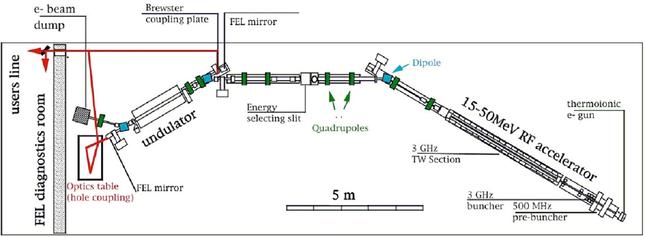CLIO
CLIO is a pulsed free-electron laser continuously tunable between 3 and 120 µm. It has a double pulsed structure: "macro-pulses" 10 µs long (at 1 to 25 Hz) contain "micro-pulses" of length adjustable from 0.3 to 5 ps (with Fourier transform spectral width). The micropulse interval is 16 ns. CLIO can lase simultaneously at 2 different, independently tunable frequencies, allowing 2-colours pump-probe experiments.
User facility
Vacuum beamlines transport the optical beam to 8 user rooms. They include various equipment : mirrors, detectors, optical mounts, monochromators, cryostats, etc. The users have computer control of the laser wavelength and spectral scans. In addition, 4 different set-ups are available. 3 of them are operated by permanent scientists :
• A sum frequency generation (SFG) experiment, dedicated to surface studies. This installation includes a short pulse (5 ps) Nd:YAG laser synchronized with CLIO and the computerized control of the experiment. Optical parametric oscillators are pumped by this Nd:YLF laser and are synchronized with CLIO. They cover the visible and near-infrared up to 8-9 µm. This allows to vary both the visible and infrared wavelengths in the SFG set-up as well as multicolor experiment. This permits the studies of surfaces in various conditions: in electrochemical cells, in air and under ultra high vacuum (UHV).
• Mass spectrometers allow ultra-sensitive gas phase spectroscopy by multiphoton dissociation (IRMPD) driven by the infrared FEL. It has been shown that this combination is highly effective in identifying reaction intermediates. Many are available to users. In particular, a Paul trap is available and a 7T ICR spectrometer and installed in a newly adapted room of CLIO in 2010. Several ion preparation chambers and electron gun to fragment ions are available. A high power ns-OPO is also coupled to the spectrometer, making this installation a unique set-up in the world.
• A near-field infrared microscope with spatial resolution < 100 nm capable of local spectroscopy and microscopy (“chemical mapping”). A new technique, called AFMIR, has been developped at CLIO. It allows to overcome the probleme encountered when one wants to perform spectroscopy under the Rayleigh (~l) limit for spatial resolution. It is based on a photo-thermal method, providing a direct measurement of the infrared absorption, avoiding influence of the real part (topography) of the index of refraction. It is also coupled with an OPO laser, allowing developments in near-infrared complementing CLIO. The lateral resolution is better than 100 nm.
• A pump-probe and photon echo experiment (no permanent scientist)
Call for proposals
The proposals are reviewed by an international Programm Committee. The use of CLIO is free of charge for the academic community. Under the 7th PCRD of the European Union, it is expected that travel and living expenses may be refunded for a researcher who is normally working in one of the States of the Community or Associated States.
more information
|
Beam parameters |
Value |
|---|---|
|
Spectral range [µm] |
3 - 120 |
|
Polarization |
Linear |
|
Minimum Spectral width D1 [%] |
0.2 - 1 |
|
Stability in wavelength [%] |
0.1 |
|
Macropulse length [µs] |
1 - 9 (tunable) |
|
Micropulse [ps] |
0.3 - 5 (tunable) |
|
Peak power [MW] |
10 - 100 |
|
Maximum average power [W] |
1.5 (25 Hz, 16 ns/micro-pulse) |
|
2-coulours FEL [µm] |
Tested up to 32 |
|
OPOS [µm] |
2 - 8 |

